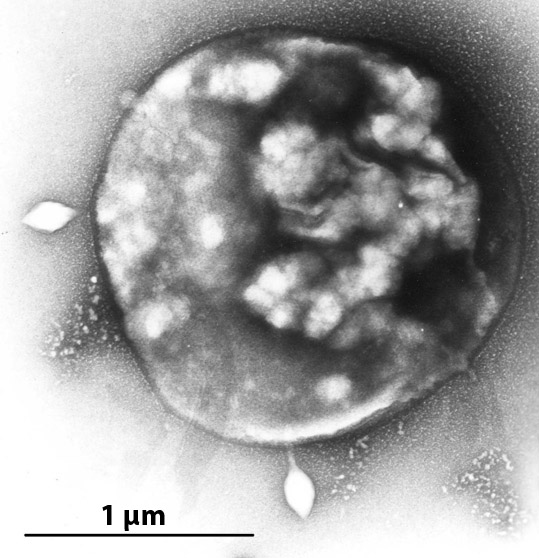|
Alphaguttavirus
''Alphaguttavirus'' is a genus of viruses, in the family ''Guttaviridae''. ''Sulfolobus ''Sulfolobus'' is a genus of microorganism in the family Sulfolobaceae. It belongs to the archaea domain. ''Sulfolobus'' species grow in volcanic springs with optimal growth occurring at pH 2-3 and temperatures of 75-80 °C, making them ... newzealandicus'' serve as natural hosts. There is only one species in this genus: ''Sulfolobus newzealandicus droplet-shaped virus''. Structure Viruses in the genus ''Alphaguttavirus'' are enveloped. The diameter is around 70-95 nm, with a length of 110-185 nm. Genomes are circular, around 20kb in length. Life cycle DNA-templated transcription is the method of transcription. ''Sulfolobus newzealandicus'' serve as the natural host. References External links ICTV Online Report ''Guttaviridae'' {{Taxonbar, from=Q18819223 Archaeal viruses Guttaviridae Virus genera ... [...More Info...] [...Related Items...] OR: [Wikipedia] [Google] [Baidu] |
Guttaviridae
''Guttaviridae'' is a family of viruses. Archaea serve as natural hosts. There are two genera in this family, containing one species each. The name is derived from the Latin ''gutta'', meaning 'droplet'.Mochizuki T, Sako Y, Prangishvili D (2011) Provirus induction in hyperthermophilic Archaea: Characterization of Aeropyrum pernix spindle-shaped virus 1 and Aeropyrum pernix ovoid virus 1. J Bacteriol 193(19):5412–5419Arnold HP, Ziese U and Zillig W (2000). SNDV, a novel virus of the extremely thermophilic and acidophilic archaeon ''Sulfolobus''. Virology 272:409–16. Taxonomy The family contains the following genera and species: * ''Alphaguttavirus'' ** ''Sulfolobus newzealandicus droplet-shaped virus'' * ''Betaguttavirus'' ** ''Aeropyrum pernix ovoid virus 1'' Structure Viruses in the family ''Guttaviridae'' are enveloped. The diameter is around 70–95 nm, with a length of 110–185 nm. Genomes are circular, around 20kb in length. The virons consist of a coat, a co ... [...More Info...] [...Related Items...] OR: [Wikipedia] [Google] [Baidu] |
Viruses
A virus is a submicroscopic infectious agent that replicates only inside the living cells of an organism. Viruses infect all life forms, from animals and plants to microorganisms, including bacteria and archaea. Since Dmitri Ivanovsky's 1892 article describing a non-bacterial pathogen infecting tobacco plants and the discovery of the tobacco mosaic virus by Martinus Beijerinck in 1898,Dimmock p. 4 more than 9,000 virus species have been described in detail of the millions of types of viruses in the environment. Viruses are found in almost every ecosystem on Earth and are the most numerous type of biological entity. The study of viruses is known as virology, a subspeciality of microbiology. When infected, a host cell is often forced to rapidly produce thousands of copies of the original virus. When not inside an infected cell or in the process of infecting a cell, viruses exist in the form of independent particles, or ''virions'', consisting of (i) the genetic material, i.e ... [...More Info...] [...Related Items...] OR: [Wikipedia] [Google] [Baidu] |
Sulfolobus
''Sulfolobus'' is a genus of microorganism in the family Sulfolobaceae. It belongs to the archaea domain. ''Sulfolobus'' species grow in volcanic springs with optimal growth occurring at pH 2-3 and temperatures of 75-80 °C, making them acidophiles and thermophiles respectively. ''Sulfolobus'' cells are irregularly shaped and flagellar. Species of ''Sulfolobus'' are generally named after the location from which they were first isolated, e.g. ''Sulfolobus solfataricus'' was first isolated in the Solfatara volcano. Other species can be found throughout the world in areas of volcanic or geothermal activity, such as geological formations called mud pots, which are also known as ''solfatare'' (plural of solfatara). ''Sulfolobus'' as a model to study the molecular mechanisms of DNA replication When the first Archaeal genome, '' Methanococcus jannaschii'', had been sequenced completely in 1996, it was found that the genes in the genome of ''Methanococcus jannaschii'' involv ... [...More Info...] [...Related Items...] OR: [Wikipedia] [Google] [Baidu] |
Archaeal Viruses
An archaeal virus is a virus that infects and replicates in archaea, a domain of unicellular, prokaryotic organisms. Archaeal viruses, like their hosts, are found worldwide, including in extreme environments inhospitable to most life such as acidic hot springs, highly saline bodies of water, and at the bottom of the ocean. They have been also found in the human body. The first known archaeal virus was described in 1974 and since then, a large diversity of archaeal viruses have been discovered, many possessing unique characteristics not found in other viruses. Little is known about their biological processes, such as how they replicate, but they are believed to have many independent origins, some of which likely predate the last archaeal common ancestor (LACA). Much of the diversity observed in archaeal viruses is their morphology. Their complete bodies, called virions, come in many different forms, including being shaped like spindles or lemons, rods, bottles, droplets, and coils ... [...More Info...] [...Related Items...] OR: [Wikipedia] [Google] [Baidu] |
